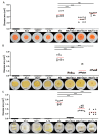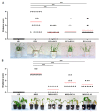Screening, Identification and Efficacy Evaluation of Antagonistic Bacteria for Biocontrol of Soft Rot Disease Caused by Dickeya zeae
- PMID: 32397545
- PMCID: PMC7285164
- DOI: 10.3390/microorganisms8050697
Screening, Identification and Efficacy Evaluation of Antagonistic Bacteria for Biocontrol of Soft Rot Disease Caused by Dickeya zeae
Abstract
Dickeya zeae is the causal agent of bacterial soft rot disease, with a wide range of hosts all over the world. At present, chemical agents, especially agricultural antibiotics, are commonly used in the prevention and control of bacterial soft rot, causing the emergence of resistant pathogens and therefore increasing the difficulty of disease prevention and control. This study aims to provide a safer and more effective biocontrol method for soft rot disease caused by D. zeae. The spot-on-lawn assay was used to screen antagonistic bacteria, and three strains including SC3, SC11 and 3-10 revealed strong antagonistic effects and were identified as Pseudomonas fluorescens, P. parafulva and Bacillus velezensis, respectively, using multi-locus sequence analysis (MLSA) based on the sequences of 16S rRNA and other housekeeping genes. In vitro antimicrobial activity showed that two Pseudomonas strains SC3 and SC11 were only antagonistic to some pathogenic bacteria, while strain 3-10 had broad-spectrum antimicrobial activity on both pathogenic bacteria and fungi. Evaluation of control efficacy in greenhouse trials showed that they all restrained the occurrence and development of soft rot disease caused by D. zeae MS2 or EC1. Among them, strain SC3 had the most impressive biocontrol efficacy on alleviating the soft rot symptoms on both monocotyledonous and dicotyledonous hosts, and strain 3-10 additionally reduced the occurrence of banana wilt disease caused by Fusarium oxysporum f. sp. cubensis. This is the first report of P. fluorescens, P. parafulva and B. velezensis as potential bio-reagents on controlling soft rot disease caused by D. zeae.
Keywords: antagonistic bacterial screening; determination of biocontrol effect; species identification.
Conflict of interest statement
The authors declare no conflict of interest.
Figures






Similar articles
-
Isolation, identification, and evaluation of the biocontrol potential of a Bacillus velezensis strain against tobacco root rot caused by Fusarium oxysporum.J Appl Microbiol. 2023 Jan 23;134(1):lxac049. doi: 10.1093/jambio/lxac049. J Appl Microbiol. 2023. PMID: 36626796
-
Identification of Dickeya zeae as a Causal Agent of Bacterial Soft Rot in Banana in China.Plant Dis. 2014 Apr;98(4):436-442. doi: 10.1094/PDIS-07-13-0711-RE. Plant Dis. 2014. PMID: 30708726
-
Potential of bulb-associated bacteria for biocontrol of hyacinth soft rot caused by Dickeya zeae.J Appl Microbiol. 2009 Jan;106(1):268-77. doi: 10.1111/j.1365-2672.2008.04000.x. Epub 2008 Nov 29. J Appl Microbiol. 2009. PMID: 19054227
-
The Changing Face of Bacterial Soft-Rot Diseases.Annu Rev Phytopathol. 2018 Aug 25;56:269-288. doi: 10.1146/annurev-phyto-080417-045906. Epub 2018 Jun 29. Annu Rev Phytopathol. 2018. PMID: 29958075 Review.
-
Identification of antagonistic yeasts as potential biocontrol agents: Diverse criteria and strategies.Int J Food Microbiol. 2023 Dec 2;406:110360. doi: 10.1016/j.ijfoodmicro.2023.110360. Epub 2023 Aug 10. Int J Food Microbiol. 2023. PMID: 37591131 Review.
Cited by
-
Genomic and phenotypic biology of a novel Dickeya zeae WH1 isolated from rice in China: Insights into pathogenicity and virulence factors.Front Microbiol. 2022 Oct 28;13:997486. doi: 10.3389/fmicb.2022.997486. eCollection 2022. Front Microbiol. 2022. PMID: 36386707 Free PMC article.
-
Comparative Pathogenomic Analysis of Two Banana Pathogenic Dickeya Strains Isolated from China and the Philippines.Int J Mol Sci. 2022 Oct 22;23(21):12758. doi: 10.3390/ijms232112758. Int J Mol Sci. 2022. PMID: 36361548 Free PMC article.
-
In Vitro Study of Biocontrol Potential of Rhizospheric Pseudomonas aeruginosa against Pathogenic Fungi of Saffron (Crocus sativus L.).Pathogens. 2021 Nov 2;10(11):1423. doi: 10.3390/pathogens10111423. Pathogens. 2021. PMID: 34832579 Free PMC article.
-
A novel bacterial strain Burkholderia sp. F25 capable of degrading diffusible signal factor signal shows strong biocontrol potential.Front Plant Sci. 2022 Nov 24;13:1071693. doi: 10.3389/fpls.2022.1071693. eCollection 2022. Front Plant Sci. 2022. PMID: 36507382 Free PMC article.
-
Pseudomonas forestsoilum sp. nov. and P. tohonis biocontrol bacterial wilt by quenching 3-hydroxypalmitic acid methyl ester.Front Plant Sci. 2023 Jun 30;14:1193297. doi: 10.3389/fpls.2023.1193297. eCollection 2023. Front Plant Sci. 2023. PMID: 37457350 Free PMC article.
References
-
- Samson R.G., Legendre J.B., Christen R., Saux M.F., Achouak W., Gardan L. Transfer of Pectobacterium chrysanthemi (Burkholder et al. 1953) Brenner et al. 1973 and Brenneria paradisiaca to the genus Dickeya gen. nov. as Dickeya chrysanthemi comb. nov. and Dickeya paradisiaca comb. nov. and delineation of four novel species, Dickeya dadantii sp. nov., Dickeya dianthicola sp. nov., Dickeya dieffenbachiae sp. nov. and Dickeya zeae sp. nov. Int. J. Syst. Evol. Microbiol. 2005;55:1415–1427. - PubMed
-
- Goto M. Bacterial Foot Rot of Rice Caused by a Strain of Erwinia chrysanthemi. Phytopathology. 1979;69:213–216. doi: 10.1094/Phyto-69-213. - DOI
-
- Liu Q.G., Wang Z.Z. Infection characteristics of Erwinia chrysanthemi pv. zeae on rice. J. South China Agric. Univ. 2004;25:55–57.
-
- Kumar A., Hunjan M.S., Kaur H., Dhillon H.K., Singh P.P. Biochemical responses associated with resistance to bacterial stalk rot caused by Dickeya zeae in maize. J. Phytopathol. 2017;165:822–832. doi: 10.1111/jph.12622. - DOI
Grants and funding
- 31972230/National Natural Science Foundation of China
- 2018B020205003/Key Realm of R&D Program of Guangdong Province
- 2020A1515011534/Natural Science Foundation of Guangdong Province, China
- SKLCUSA-b201908/State Key Laboratory for Conservation and Utilization of Subtropical Agro-bioresources
- 2017A010105009/Science and Technology Planning Project of Guangdong Province
LinkOut - more resources
Full Text Sources
Other Literature Sources

